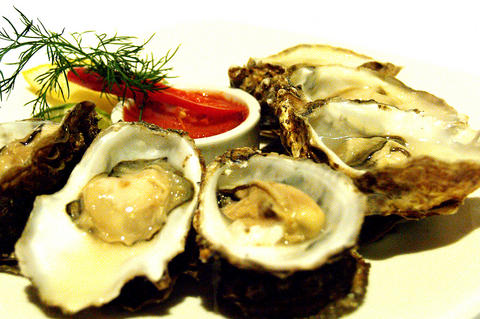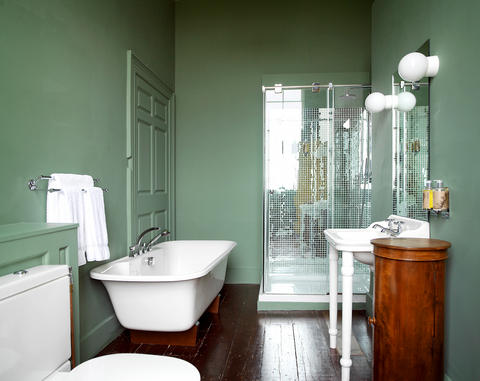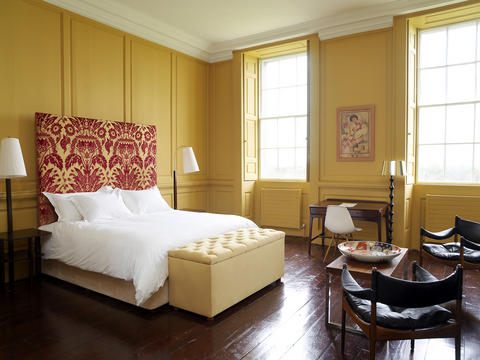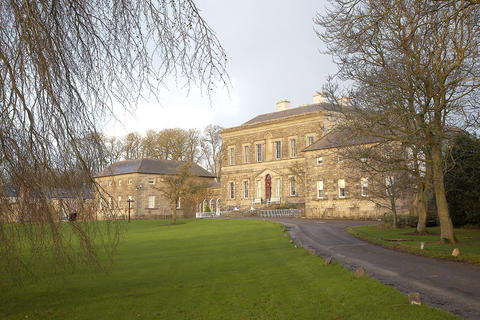The drawing room of Bellinter House has many classic Georgian features. There are wide, dark-stained timber floorboards, soaring floor-to-ceiling sash windows with paneled shutters, and deep cornices supporting a ceiling of elaborate ornamental plasterwork. But look at the furnishings of this fine 1750 Palladian-style hotel, 50km north of Dublin, and you could be forgiven for thinking that you've wandered into a funky urban bachelor pad. There are glass-and-chrome coffee tables, 1950s leather armchairs, and two paper-and-wire wall lights playfully shaped into antelope and bison trophy heads.
This mingling of traditional rural mansion and eclectic contemporary styling is well established in Britain, at such "groovy grand" hotels as Cowley Manor in the Cotswolds, The Grove in Hertfordshire and Babington House in Somerset, but Bellinter is a departure for the Irish hotel market.
Pitched somewhere between the boutique bling of designer hangouts such as Dublin's Morrison and Galway's G Hotel, and the more genteel surroundings of country houses like Ballymaloe House in County Cork and Castle Leslie in County Monaghan, Bellinter has attracted much attention since it opened last December.

PHOTOS: COURTESY OF BELLINTER HOUSE
This is partly because the hotel is co-owned by one of the country's most successful businessmen, Jay Bourke. With partners Eoin Foyle and John Reynolds, Bourke has opened a dozen or more clubs, bars and restaurants, mostly in Dublin, over the past 15 years, from the POD and Ri-Ra nightclubs to the budget Cafe Bar Deli restaurant chain and the Odessa private members' club. "When we were in our 20s, we opened nightclubs; when we were in our 30s, we opened restaurants; and now we're in our 40s it seems only right to open a hotel," says Bourke, 41.
Bellinter is for fashionable city folk caught socially somewhere between the night club and the golf club; a country house hotel for the acid house generation. The three-year, £1 million renovation and redevelopment of the house was overseen by one of Ireland's hippest architects and designers, Pierce Tynan, who has created a feel of what he calls "threadbare elegance." While the preserved buildings - a main house with projecting wings and connecting colonnades designed by the renowned architect Richard Castle, who created the Irish parliament building, Leinster House - have been meticulously restored, there is no excessive purity about the hotel.
One of the reception rooms is now a games room, complete with wall-mounted flat-screen television and blue-baized American pool table, and in the library there is an old oxblood leather Chesterfield armchair that has a front leg propped up by two blocks of wood. The guiding hand here is humorous, honest, slightly leftfield.

It's an approach that extends to the 34 bedrooms, some of which are in former outbuildings. All have hi-tech features such as multimedia, 40-inch LCD televisions, Bose sound systems, wireless Internet access, and remote-control lighting. There are luxuries such as extra-large beds, Frette bed linen and goose feather pillows.
The country-urban feel is completed with bespoke Japanese-style wardrobes handmade in Irish ash, and cowhide rugs sourced from a local tannery. There is the obligatory spa, but again with interesting twists; a range of modern treatments are available in the seven treatment rooms, but there are also traditional seaweed baths. Elsewhere, there is an indoor swimming pool with a sauna and steam room, an outdoor hot tub, and a heated infinity pool with fine views over the river Boyne.
Brown trout fishing is also available; Bellinter has rights to a 4.8km stretch of river. One of Europe's most important and fascinating Neolithic monuments, the passage graves at Newgrange, older than the Pyramids, is around half an hour away by car. Bellinter is very much a work in progress, with more facilities opening over the coming months. Past the two giant, 250-year-old beech trees on the front lawn, two more outbuildings are being converted into a cinema and children's playhouse; the latter will have a miniature version of the nearby Hill of Tara, the mythical seat of the high kings of Celtic Ireland. Diarmuid Gavin's "pavilion pod," a silver medal winner at last year's Chelsea Flower Show, will also have a permanent home in the gardens by the end of the year.

Unfortunately, the unfinished nature of the project seems occasionally to extend to the service. The staff is young, friendly and very willing to help, but sometimes their inexperience shows. If you're paying up to £260 (NT$17,200) for a room, you don't expect the hotel barman to greet you with "yes, mate." You are not in a Dublin boozer; you are in a wonderful mahogany and marble bar, the traditional vibe of which has been subverted by a specially commissioned mural by leading Irish artist David Godbold of an angel looking down on a fairy-tale mountain landscape.
The vaulted cellar restaurant, sister to Bourke's Eden brasserie in Dublin, can feel a bit austere on sunny mornings and early evenings, although breakfasts and lunches are served on the back lawn, weather permitting. The sound of the space needs more care, too; the Gotan Project's La Revancha del Tango CD, in itself a ubiquitous cliche, was played on a loop for all four meals we had in the restaurant. Still, these are small quibbles in a new hotel that gets many more things right than wrong. Not only have Bourke and his team thoughtfully and intelligently restored a landmark Irish property, they have also captured a sense of a long history of hospitality. Bellinter seems somehow to embody the Irish gift for mixing people up and making them feel comfortable.
As Bourke says: "Bellinter is a very happy, very egalitarian, and very Irish country house."

On the Net: www.bellinterhouse.com.

May 11 to May 18 The original Taichung Railway Station was long thought to have been completely razed. Opening on May 15, 1905, the one-story wooden structure soon outgrew its purpose and was replaced in 1917 by a grandiose, Western-style station. During construction on the third-generation station in 2017, workers discovered the service pit for the original station’s locomotive depot. A year later, a small wooden building on site was determined by historians to be the first stationmaster’s office, built around 1908. With these findings, the Taichung Railway Station Cultural Park now boasts that it has

Wooden houses wedged between concrete, crumbling brick facades with roofs gaping to the sky, and tiled art deco buildings down narrow alleyways: Taichung Central District’s (中區) aging architecture reveals both the allure and reality of the old downtown. From Indigenous settlement to capital under Qing Dynasty rule through to Japanese colonization, Taichung’s Central District holds a long and layered history. The bygone beauty of its streets once earned it the nickname “Little Kyoto.” Since the late eighties, however, the shifting of economic and government centers westward signaled a gradual decline in the area’s evolving fortunes. With the regeneration of the once

The latest Formosa poll released at the end of last month shows confidence in President William Lai (賴清德) plunged 8.1 percent, while satisfaction with the Lai administration fared worse with a drop of 8.5 percent. Those lacking confidence in Lai jumped by 6 percent and dissatisfaction in his administration spiked up 6.7 percent. Confidence in Lai is still strong at 48.6 percent, compared to 43 percent lacking confidence — but this is his worst result overall since he took office. For the first time, dissatisfaction with his administration surpassed satisfaction, 47.3 to 47.1 percent. Though statistically a tie, for most

In February of this year the Taipei Times reported on the visit of Lienchiang County Commissioner Wang Chung-ming (王忠銘) of the Chinese Nationalist Party (KMT) and a delegation to a lantern festival in Fuzhou’s Mawei District in Fujian Province. “Today, Mawei and Matsu jointly marked the lantern festival,” Wang was quoted as saying, adding that both sides “being of one people,” is a cause for joy. Wang was passing around a common claim of officials of the People’s Republic of China (PRC) and the PRC’s allies and supporters in Taiwan — KMT and the Taiwan People’s Party — and elsewhere: Taiwan and